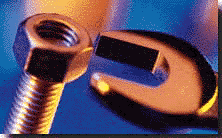



Noted the above procedure is a little complex and requires an oil & oil-filter
change. The benefits can be felt on any engines after about 36-60k miles.
Last Upload: 31st January, 2002. V1.50a
Decarbon Procedure & Noise Diagnosis
 Pre-Emptive - Regular use of Techron or Redline SI1/SI2 in the petrol tank
Pre-Emptive - Regular use of Techron or Redline SI1/SI2 in the petrol tank Full TSB Solution, TSB 96113 Dated May 1996
Full TSB Solution, TSB 96113 Dated May 1996
1. Bring engine to normal operating temperature, then shut engine off.
2. Use a 61cm length of 1/8" I.D. vacuum hose as a feed tube for carb
cleaner (Carburetor Tune-up Cleaner, ford # D9AZ-19579-BA), although it
is strongly advised to use an aerosol cleaner to eliminate
the risk of liquid loc. Do not use any of the vehicle's vacuum hoses for
feeding cleaner into the engine otherwise they may deteriorate as a result.
3. Connect one end of the feed tube to the Purge Control vacuum port on the upper
intake manifold and place the other end of the feed tube in the can of carb cleaner,
or to the spray nozzle of an aerosol. If a liquid bottle is used the feed rate must
be at least 30 secs to avoid hydraulic lock-up damage.
4. Pinch the feed-tube with locking forceps or locking pliars to prevent suction
during start-up.
5. Restart engine.
6. Allow idle to stabilise, then feed the cleaner into the engine by releasing
the locking pliars/forceps while lifting engine speed to 3000rpm until half
the cleaner is used. If using liquid feed, ensure feed-rate is always erring
on the safe side by kinking the tube (a thumb screw clamp is ideal). If using
a spray feed (preferred) keep shaking the can vigorously. At the half point
allow the engine to stall, or shut-it off.
7. The vehicle should be left to sit for 6-24hrs allowing the cleaner to saturate
the carbon, the initial intake of cleaner loosens carbon by both dissolving
and also by a cold-shock.
8. Flush remaining carbon by repeating the above steps using the remaining half
of the carb cleaner. Do not let the engine stall during the procedure.
9. Remove the feed tube & reconnect the purge control vacuum line.
10. Change oil & oil filter to remove contaminants & carbon in the oil
which will otherwise be pumped through all the HLAs.
11. Take the car on a 3-4 mile test drive, using the full-rpm range to remove any
remaining cleaner or carbon from the engine.
12. Let the car sit for another 12hrs, restart - if the noise is gone then the
cause of the noise was carbon build-up.
 Full TSB re Noise from
Carbon-Knock/HLA/Friction Gear see:
Full TSB re Noise from
Carbon-Knock/HLA/Friction Gear see:

URL: http://homepage.ntlworld.com/dorothy.bradbury/probemx/p_p13.htm